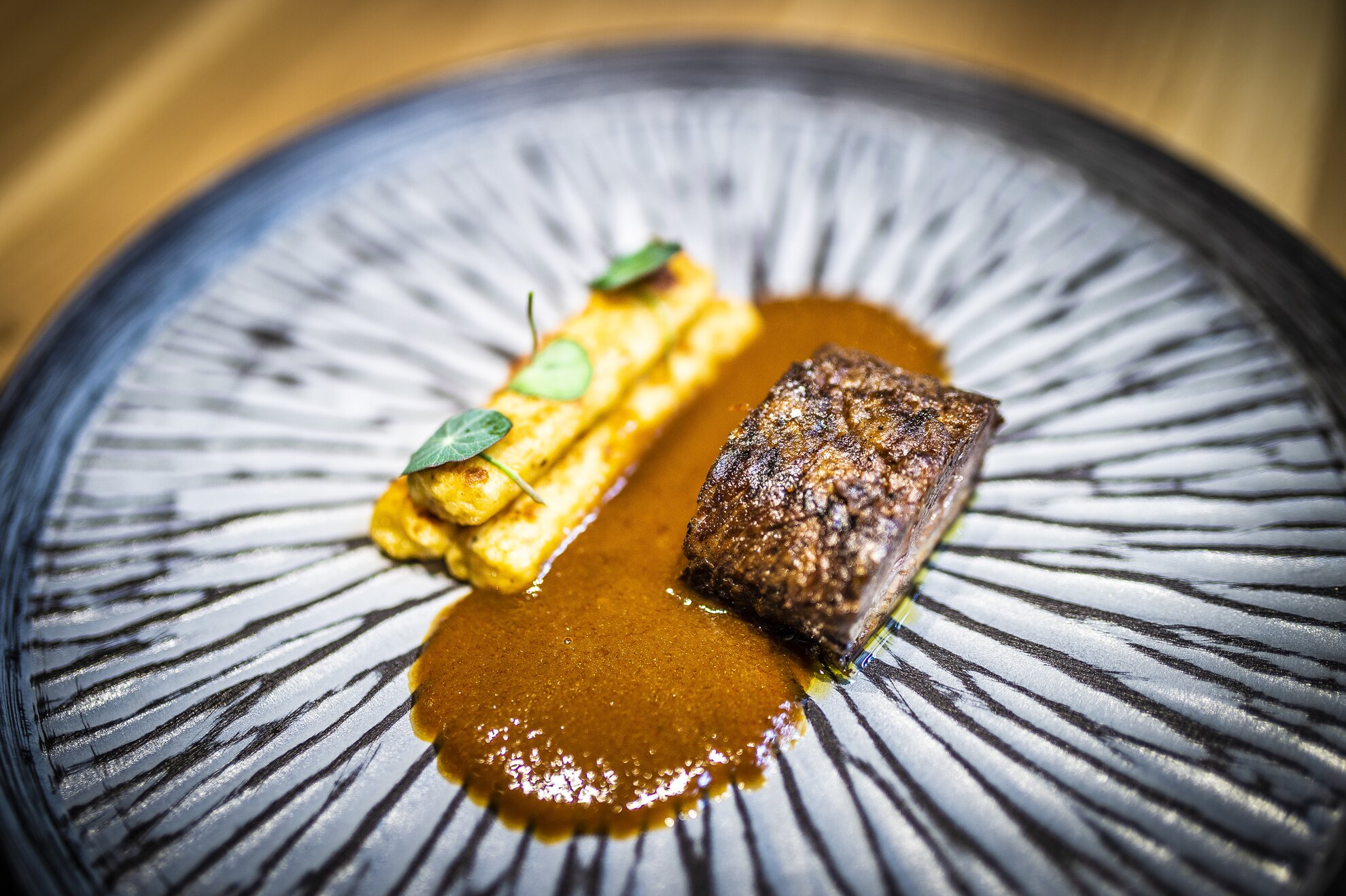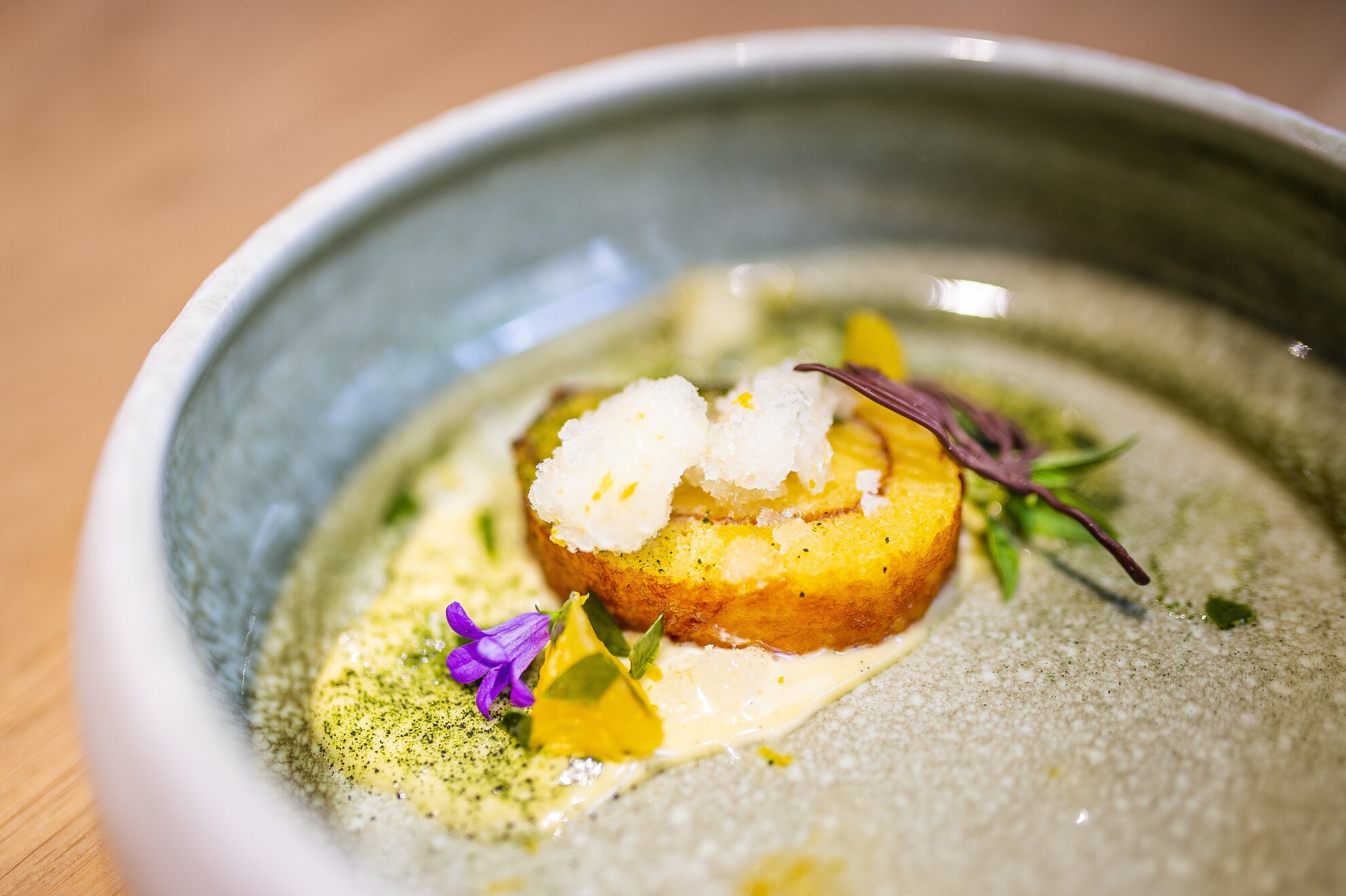Tiago Sabarigo came from the Michelin-starred Pétrus by Gordon Ramsay in Knightsbridge, straight to the equally anointed Costes Downtown in the heart of Budapest. His wife, Éva Jenei, is well-versed in the hotel trade. For some time, they had been planning their own restaurant, combining Portuguese and Hungarian cuisine: essência Restaurant Tiago & Éva, just opened on Sas utca.

The interior clearly shows its Portuguese influences yet there is no forced maritime effect. The walls are made of bare brick and Portuguese blue-and-white tiles, interspersed with deep navy-blue surfaces and a white lattice structure. The front part of the restaurant is a bit brighter, at the back, next to the huge wine cooler, the atmosphere is a bit more intimate and hidden. If you sit at the right table, you can keep an eye on Tiago and his team perfecting their cuisine.

In the absence of a terrace, the wall onto the street front is almost completely open, and due to the white shutters, there is a strong, homely, maritime atmosphere to the interior, with clean wooden tables and colourful chairs, designed by TV star Gianni Annoni. It doesn’t quite say fine dining but you know you’re in a place that focuses on high-quality cuisine before you even open the menu.

There are, in fact, two menus, one for lunch and the other for dinner. If you only have a modest budget to investigate this new venture, come at lunchtime to sample two dishes for 3,900 forints and three for 4,800 – there’s also à la carte. Dinner is selected from a fixed menu, Hungarian, Portuguese or, the key here, essência, a fusion of the two.
The first two consist of five elements, 16,800 forints without a wine pairing, the combination comprises eight items at 21,900 forints, again, before drinks. However, it’s well worth tasting the wines, because they offer excellent examples from small wineries from Hungary and Portugal.

The welcoming hors d'oeuvre, a fish meatloaf reminiscent of the world of Portuguese street food – in fact, of course, cod – is served in a pretty little shell. It sums up Portuguese cuisine very nicely, simple yet rustic, a notch above the more neutral offerings of greetings at restaurants of this category.
Fortunately, the obligatory homemade sourdough bread also arrives before the first dish. Its special feature is that the slices of bread made locally are grilled in the Portuguese way. The accompanying homemade algae butter and the high-end Distintus olive oil come from a family in northern Portugal who have been growing olives for five generations, and largely supply Michelin-starred restaurants. A wedding of silky, strong, slightly bitter grassy olives and smoky homemade sourdough bread would be a perfect dish in itself.

The first course is soup, a concept so typical of Hungarian cuisine, but here given a completely Iberian twist with the cooling, refreshing gazpacho (1,900 HUF). It’s flawless, the taste of ripe tomatoes and high-quality olive oil can be perceived, the piece of grilled watermelon with its sweet, smoky taste going well with it.
The second dish is one of the best-known in the Portuguese canon: bacalhau à Brás (6,200 HUF), thinly sliced Portuguese salted cod mixed with onions, potatoes and eggs, served like a salad. In addition to the creamy, not particularly light fish base, crispy lettuce leaves are used to make it easier to match. If you are interested in Portuguese cuisine, this is a must.

In order to expand on bacalhau, octopus (5,800 HUF) also appears on the menu. Grilled baby octopus, creamy rice and sea asparagus are well-prepared here but because of their restrained flavours, it had the least rustic of the Portuguese dishes we sampled, although the bitter freshness of the sea asparagus shifted the rice and octopus in the right direction.

From the Hungarian selection, the side of beef with stew and pasta noodles (5,500 HUF) arrives with two pieces of meat cooked sous-vide flaking off softly. The elongated sticks of pasta noodles are brilliantly given an extra caramel kick, a smoky flavour from being toasted, and the whole creation is crowned by a jus noticeably prepared over long hours. As an extra, we receive a refreshing gooseberry-cucumber salad which makes us think that Tiago may have grown up somewhere on the Great Hungarian Plain, so well did it complement his stew.

Dessert is a traditional Portuguese sweet, torta de laranja (2,800 HUF). This one-slice sponge is very light and summery thanks to the egg white and sugar dough, and the orange syrup it is soaked into comes out as a slightly mottled spiral thanks to the perfumed orange blossom water in it. To offset it on the plate, it is paired with orange ice cream.

In the petit four, we find the unmissable pastel de nata, perfect, crunchy dough with a soft vanilla egg cream, a powerful, thyme-caramel chocolate ball and, since we are in Portugal by proxy, ginjinha, the unmissable Lusitanian cherry liqueur in the form of a jelly cube rolled into a springy sweet.

As Portuguese food is a little underrepresented in Budapest, Hungarian dishes likewise, a visit to essência Restaurant Tiago & Éva is doubly worthwhile. However, it is even more exciting to combine the two, as they show how a little creativity and high-quality culinary savvy can pair these two seemingly distinct cuisines.

essência Restaurant Tiago & Éva
District V. Sas utca 17
Facebook
Open: Tue 6pm-9.30pm, Wed-Sat noon-3pm, 6pm-9.30pm




